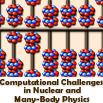Speaker
Pieter Maris
Description
The atomic nucleus is a self-bound system of strongly
interacting nucleons. In No-Core Configuration Interaction
(CI) calculations, the nuclear wavefunction is expanded in a
basis of Slater Determinants of single-nucleon wavefunctions
(Configurations), and the many-body Schrödinger equation
becomes a large sparse matrix problem. The challenge is to
reach numerical convergence to within quantifiable numerical
convergence to within quantifiable numerical uncertainties
for physical observables using finite truncations of the
infinite-dimensional basis space. I discuss the
(dis)advantages of different truncation schemes, as well as
strategies for constructing and solving the resulting large
sparse matrices of current multi-core computer
architectures. Several of these strategies have been
implemented in the code MFDn, a hybrid MPI/OpenMP Fortran
code for ab-initio nuclear structure calculations that has
been demonstrated to scale to over 200,000 cores. Finally, I
present results for ground state energies, excitation
spectra, and select electromagnetic observables for light
nuclei in the A=6 to 14 range using realistic 2- and 3-body
forces. In particular, I demonstrate that collective
phenomena such as rotational band structures can emerge from
these microscopic calculations.

